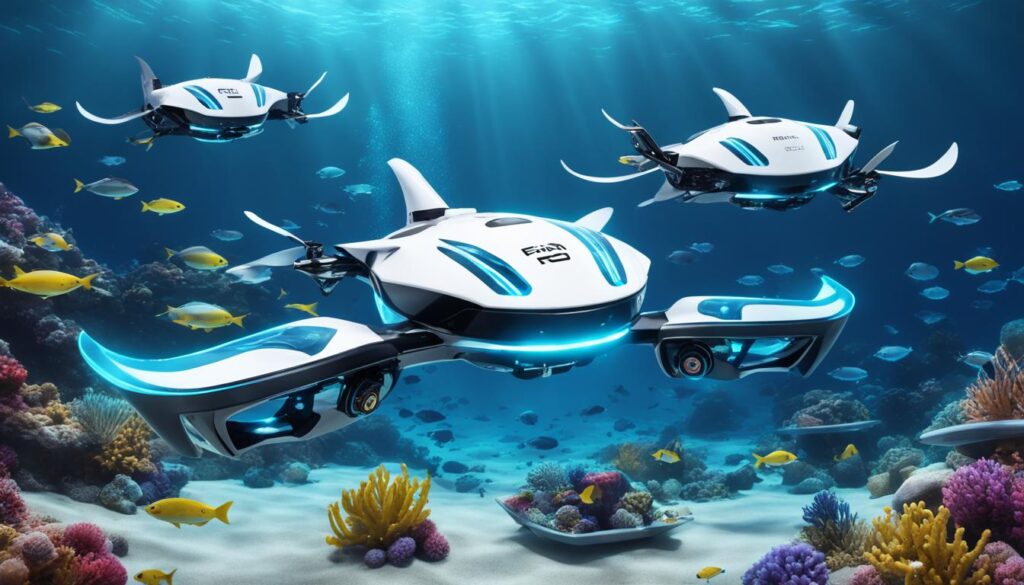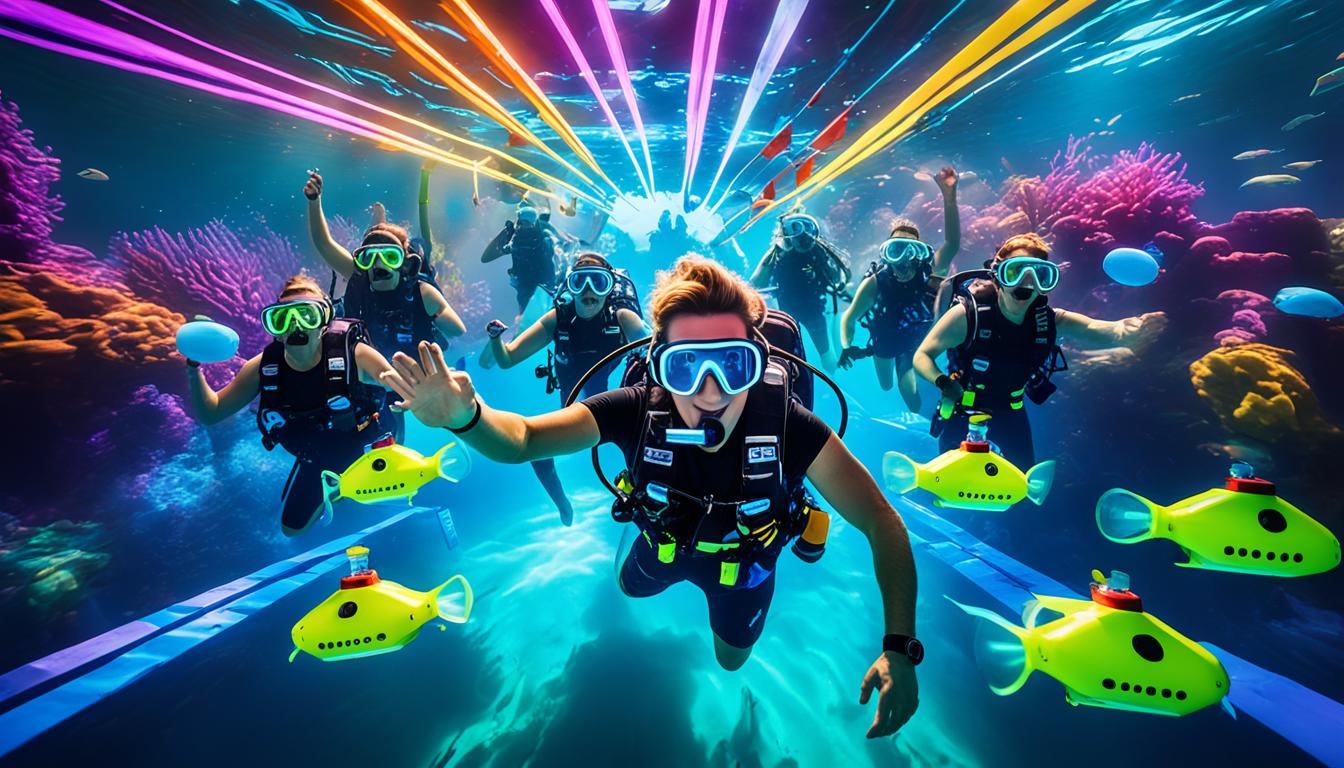The undersea world holds a treasure trove of wonders, teeming with vibrant marine life and hidden mysteries. To unlock the visual splendors beneath the waves, two innovative gadgets have surfaced in the 4K underwater drone market: the FIFISH V-EVO and the PowerVision PowerRay. These aquatic explorers are at the forefront of the underwater drone showdown, enticing professionals and enthusiasts alike with their promise of crisp, high-definition underwater footage. Join us as we dive deep into the realm of underwater exploration and pit these two technological marvels against each other in a comprehensive drone comparison.
Whether you’re a marine biologist aiming to investigate the uncharted depths, a filmmaker capturing the surreal dance of light beneath the surface, or an explorer hungry for the sights unseen by the naked eye, the FIFISH V-EVO and PowerVision PowerRay stand ready to be your eyes in the deep blue. Get your fins ready. We’re about to submerge into the ultimate duel between two of the most formidable 4K underwater drones in the industry.
Key Takeaways
- Discover how the FIFISH V-EVO and PowerVision PowerRay revolutionize underwater exploration with advanced 4K technology.
- Understand the critical specifications and features that set each drone apart in this compelling underwater drone showdown.
- Explore what these underwater drones offer for different underwater scenarios, from marine research to cinematic underwater videography.
- Anticipate a side-by-side drone comparison to determine which device offers superior capabilities, maneuverability, and user experience.
- Prepare to embark on a visual adventure as we evaluate these drones in-action, bringing you closer to making an informed decision for your underwater quests.
Introducing the Contenders: FIFISH V-EVO and PowerVision PowerRay
Underwater exploration is about to get more exhilarating with two of the most sophisticated drones on the market: the FIFISH V-EVO Underwater Drone and the PowerVision PowerRay Underwater Drone. Each is engineered with unique features that cater to both professional and recreational needs, promising to bring the marine world to the surface through impressive technology. In this drone review, we’ll navigate through the qualities that set each of these submerged explorers apart, and pit them side by side for a comprehensive comparison.
What Sets the FIFISH V-EVO Apart?
The FIFISH V-EVO stands as a paragon of underwater drone design, delivering remarkable capabilities for underwater photography and videography. This agile drone is equipped with a 4K UHD camera, ensuring crystal clear images from the depths. But it’s not just about picture quality; the V-EVO’s prowess lies in its omni-directional movement and VR smart technology, allowing for an immersive underwater exploration experience.
Key Features of the PowerVision PowerRay Drone
Conversely, the PowerVision PowerRay is equally commendable, touting features that resonate well with drone enthusiasts and professionals alike. Its user-friendly interface and Zeiss VR goggles option offer a seamless conduit between the pilot and the aquatic terrain. Furthermore, the PowerRay is celebrated for its FishFinder technology, which is a boon for those keen on unlocking the mysteries of underwater habitats or even seeking an innovative edge in fishing.
Meeting the Rivals: Comparison at a Glance
| Feature | FIFISH V-EVO | PowerVision PowerRay |
|---|---|---|
| Camera Resolution | 4K UHD | 4K UHD |
| Navigation | Omni-directional | Intelligent Orientation Control |
| Technology | VR Smart Control | FishFinder & Zeiss VR Goggles Compatibility |
| Use Case | Professional Underwater Filming | Recreational and Fishing |
Our initial reconnaissance into the stand-out capabilities of both the FIFISH V-EVO and the PowerVision PowerRay underwater drones reveals that while they share some common traits, each harbors unique features that could sway your favor depending on personal needs in underwater exploration and drone photography. Which of these underwater marvels will surface as the prime choice for your next aquatic adventure? Continue reading our drone reviews to delve deeper into the comparison.
FIFISH V-EVO vs. PowerVision PowerRay: The Ultimate 4K Underwater Drone Showdown
As the underwater realm continues to fascinate and the demand for capturing its secrets grows, the market for high-quality underwater drones is more competitive than ever. In an epic clash of subaquatic titans, the FIFISH V-EVO and PowerVision PowerRay rise to the occasion, promising unrivaled 4K capture capabilities beneath the waves. This comparison aims to dive deep into the capabilities of these sophisticated underwater drones, presenting a clear picture of what each drone offers to the enthusiasts of marine videography and exploration.

In assessing the 4K drone capabilities, several factors come under scrutiny: camera quality, navigational precision, software integration, and hardware robustness. Both drones make bold statements with their sleek designs and boast an array of features that set high expectations for performance. Whether it’s capturing the colorful corals of a reef or the dark expanses of a shipwreck, these drones are equipped to present an immersive underwater experience.
| Feature | FIFISH V-EVO | PowerVision PowerRay |
|---|---|---|
| Camera Resolution | 4K UHD | 4K UHD |
| Frame Rate | 120 fps (HD mode) | 60 fps |
| Lens Field of View | 166 degrees | 95 degrees |
| Maximum Depth | 100 meters | 30 meters |
| Battery Life | Up to 4 hours | Up to 4 hours |
| Stabilization | 6-axis gyro-stabilization | 3-axis stabilization |
The face-off isn’t just a matter of specs; it’s about the nuances that matter to end-users. For example, while both drones boast impressive 4K filming quality, the FIFISH V-EVO edges ahead with its higher frame rate and wider lens, which could be critical for capturing fast-moving scenes and achieving sweeping panoramic shots.
Moving beyond the visuals, the aspect of piloting these underwater drones adds another layer to the drone comparison. The FIFISH V-EVO’s six degrees of freedom and the PowerRay’s sonar technology promise intuitive handling and navigation. Yet, it is in their ability to relay what lies beneath in real-time without losing signal integrity that will ultimately decide their rank in this underwater drone showdown.
With both products offering a suite of features to make your dive both comprehensive and memorable, the choice between these underwater behemoths comes down to the priorities of the user. Understanding the finer details of each 4K drone will help underwater adventurers and filmmakers discern which drone will best capture the majesty of their aquatic quests.
Diving Deeper: Underwater Photography and Videography Capabilities
The quest for capturing the serene beauty of the aquatic realm has perennially driven the evolution of underwater photography and videography equipment. As such, the FIFISH V-EVO and PowerVision PowerRay’s battle extends beyond mere aesthetics, anchoring itself in the technical excellence of camera quality, illumination technology, as well as stabilization and control features essential for producing crisp, captivating underwater content.

The Vision Underwater: Camera Quality Compared
The FIFISH V-EVO and PowerVision PowerRay offer unparalleled camera quality, ensuring that underwater photography and videography enthusiasts can capture vivid details despite the challenging underwater environment. Both employ cutting-edge sensors capable of delivering high-resolution images and smooth 4K video, but nuances in lens architecture and frame rates play a pivotal role in dictating the sharpness and clarity of the captured media.
Lighting the Depths: Illumination Technologies
Amidst the opaqueness of water, advanced illumination technology is indispensable. Both drones come equipped with potent lighting systems designed to pierce through the watery veil, but evaluating their brightness levels and the spread of their beams reveals intricacies that might influence the choice of a discerning user focused on underwater videography.
Steady as She Goes: Stabilization and Control
No amount of camera prowess can compensate for shaky hands or turbulent currents, making stabilization a cornerstone of underwater filming. A comparative exploration of FIFISH V-EVO and PowerVision PowerRay showcases sophisticated gyro-stabilization mechanisms that ensure steady footage. Control is equally critical, as responsive and intuitive controls are paramount for navigating the aquatic mazes and capturing that perfect shot.
| Feature | FIFISH V-EVO | PowerVision PowerRay |
|---|---|---|
| Camera Resolution | 12 Megapixels | 12 Megapixels |
| Video Quality | 4K UHD 30fps | 4K UHD 25fps |
| Lens | 162-degree FOV | 95-degree FOV |
| Illumination | 4000 lumens LED | 450 lumen LED lights |
| Stabilization | 6-axis stabilization | 3-axis stabilization |
| Control | 5 thrusters for omnidirectional movement | 4 thrusters, less vertical maneuverability |
Usability and Maneuverability: Piloting the Depths
As we delve into the intricate details of underwater drone usability, the ease with which pilots can master controls and navigate the depths becomes crucial. The user experience starts with the initial familiarization with the drone’s piloting system and its capability to execute complex maneuvers—which is a testament to exceptional drone maneuverability.
Understanding the pilot controls is paramount for conducting successful underwater exploration. The FIFISH V-EVO and PowerVision PowerRay have both been designed with an intuitive control scheme, placing a strong emphasis on the user’s ability to quickly adapt to their systems. The drones have integrated features that simplify operation without compromising on performance, setting a high standard for underwater drone usability.
We’ve had professionals and hobbyists alike praise the smooth learning curve of the FIFISH V-EVO controls. Its responsive nature has made underwater navigation not just highly efficient, but also incredibly enjoyable.
— A seasoned marine biologist
| Feature | FIFISH V-EVO | PowerVision PowerRay |
|---|---|---|
| Control Method | Wireless Handheld Controller | Wireless Controller/Smart Device |
| Maneuverability | 360-degree movement with 6 thrusters | Vertical and horizontal stabilization |
| Learning Curve | Steep but intuitive | Moderate with smart assistance features |
| Interface Design | User-friendly with real-time navigation data | Interactive with immersive VR support |
The table above illustrates the undeniable fact that both drones have their strengths, with each bringing a different set of capabilities to the forefront of underwater exploration. However, it’s the user’s proficiency and preferences that will ultimately dictate their choice between the FIFISH V-EVO’s direct control scheme and the PowerVision PowerRay’s versatile operation modes.
- The FIFISH V-EVO boasts remarkable underwater drone maneuverability, made possible by its advanced thruster design.
- The PowerVision PowerRay answers the call for accessibility with controls that are easily adaptable for novices and experts alike.
When we consider the broad applications of these underwater drones—from filming marine life to inspecting subaquatic structures—the importance of reliable and user-centric design becomes evident. The usability and maneuverability of these technologies not only enable pilots to explore and capture the underwater world with precision but also herald a new era of aquatic discovery.
Battery Life and Endurance: Sustaining the Underwater Adventure
Embarking on an underwater journey with a drone equates to a delicate dance with time and battery capacity. The endurance of your drone not only determines the length of your adventure but also your peace of mind while exploring marine depths. In this section, we dive into a critical aspect of underwater drones: the power system that keeps them functioning beneath the waves. From the stamina that keeps the drones moving to the mechanisms that push their limits, battery life and power management are the unsung heroes of the marine odyssey.
Duration of Dive: Comparing Battery Performance
The FIFISH V-EVO and the PowerVision PowerRay offer impressive battery life that reflects the sheer technological strides in drone endurance. Keeping track of operational time is possibly the single most crucial factor in preparing for an underwater shoot or exploration. Direct comparison reveals that both drones have made considerable efforts to optimize their battery components to suit extended dives, thus offering substantial freedom to their users in planning intricate underwater missions.
On the Move: Charging Options and Power Management
Having reliable charging options can make or break the continuity of an underwater expedition. Not all charging systems are created equal, and the flexibility offered by the charging solutions of these drones can enhance the user experience by reducing downtime. Portability of chargers and the speed at which they repower the drones are pivotal in maintaining a flow in operations. In-depth exploration of power management systems also provides insights into how effectively these drones utilize their stored energy, balancing performance with power conservation.
Resilience: Handling Pressure and Depth Challenges
Endurance in the context of underwater drones encompasses more than just battery life — it includes their resilience in facing the unyielding opposites of pressure and depth. As they dive deeper into aquatic realms, the FIFISH V-EVO and PowerVision PowerRay are subjected to the immense pressure of the underwater environment. It is essential for these high-tech marvels to be designed with structural integrity to withstand such conditions without compromising their battery compartment or power management systems. Assessing how well-suited these drones are in navigating the pressure differentials across varying depths provides enthusiasts with realistic expectations of the drone’s capabilities and limitations.
Conclusion
The battle of the 4K underwater drones has been fiercely contested. After plunging into the depths of technology, performance, and versatility, it’s time to resurface with a verdict in the FIFISH V-EVO vs. PowerVision PowerRay challenge. Both drones have showcased their strengths in this 4K underwater drone showdown, capturing the intricate beauty of underwater exploration in high-definition detail. The FIFISH V-EVO dazzles with its robust build and advanced maneuverability, while the PowerVision PowerRay scores with its user-friendly experience and accessible controls.
Considering the nuances of each drone, from the crispness of their cameras to the reliability of their battery lives, choosing a clear winner is not without its challenges. For those prioritizing technological sophistication and cutting-edge camera performance for professional-grade underwater videography, the FIFISH V-EVO may hold the edge. Conversely, enthusiasts or newcomers to underwater drones might find the PowerVision PowerRay’s intuitive design and ease of use more aligned with their needs.
An informed decision in this realm of underwater exploration depends greatly on the individual’s priorities and the intended use of the device. Yet, one cannot overlook the incredible advancements both drones have brought to the market. Whether readers lean towards the immersive, high-octane capabilities of the FIFISH V-EVO or the approachable, steady reliability of the PowerVision PowerRay, this comparison has aimed to provide a clear, comprehensive understanding of what each drone offers. As we conclude this review, may your aquatic adventures be as boundless as the oceans these drones are designed to explore. Dive in with knowledge, and let your underwater journey begin!

